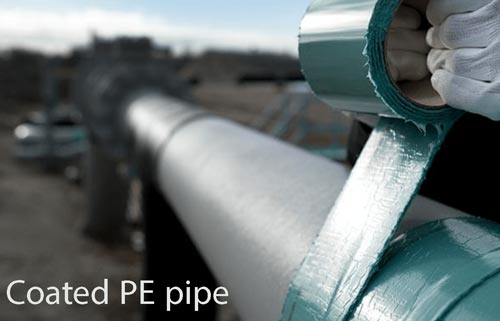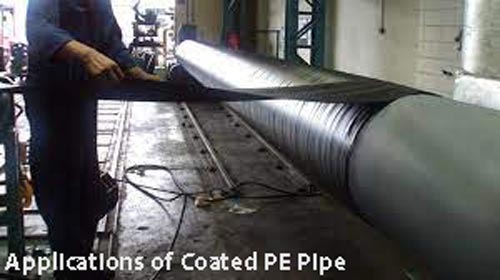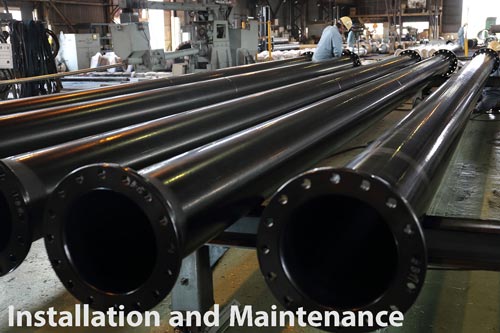Coated PE pipe
Introduction
Coated PE pipe is a type of plastic pipe that has been coated with a protective layer on its surface. The coating is typically made from materials such as epoxy, polyurethane, or polypropylene, and is applied through a process known as extrusion coating or lamination. Coated PE pipe offers numerous advantages over traditional metal pipes, including its lightweight, durability, and resistance to environmental factors such as chemicals, UV radiation, and temperature extremes. In this article, we will explore the various coating materials and processes used for coated PE pipe, the properties and applications of this type of pipe, and best practices for installation and maintenance.

Coating Materials
There are several coating materials used for coated PE pipe, each with its own of advantages and disadvantages. Here are some of the most commonly used coating materials:
Epoxy
Epoxy is a thermosetting polymer that is known for its high resistance to chemicals and corrosion. It can be applied in a thick or thin layer, and can be formulated to be either rigid or flexible. Epoxy-coated PE pipes are commonly used in the oil and gas industry, as well as in water treatment and sewage applications.
Polyurethane
Polyurethane is a thermoplastic polymer that is known for its toughness, abrasion resistance, and flexibility. It can be applied in a thick or thin layer, and can be formulated to be either rigid or flexible. Polyurethane-coated PE pipes are commonly used in the mining industry, as well as in water and wastewater applications.
Polypropylene
Polypropylene is a thermoplastic polymer that is known for its resistance to chemicals and UV radiation. It can be applied in a thin layer and is typically used for coating small-diameter pipes. Polypropylene-coated PE pipes are commonly used in chemical processing and wastewater treatment applications.
Others
Other coating materials that can be used for coated PE pipes include PVC (polyvinyl chloride), HDPE (high-density polyethylene), and FBE (fusion-bonded epoxy). Each of these materials has its own of advantages and disadvantages, and the choice of coating material will depend on factors such as the specific application, the environment in which the pipe will be used, and the desired properties of the pipe.
In general, the coating material should be chosen based on its ability to provide the necessary level of protection for the pipe, while also being compatible with the PE material and the application environment. Factors such as cost, durability, and ease of application should also be taken into consideration when selecting a coating material.
Coating Processes
There are two main coating processes used for coated PE pipe: extrusion coating and lamination. Here's an overview of each process:
Extrusion coating
Extrusion coating involves applying a molten coating material to the surface of the PE pipe using an extrusion die. The coating material is melted and then forced through a die, which shapes it into a thin layer and applies it to the pipe. The coated pipe is then cooled to solidify the coating and form a strong bond between the coating and the pipe. Extrusion coating is a fast and efficient process that can be used to coat pipes of varying sizes and shapes.
Lamination
Lamination involves bonding a pre-fabricated film or sheet of coating material to the surface of the PE pipe using an adhesive. The coating material is first produced as a sheet or film, which is then applied to the pipe using an adhesive. The coated pipe is then heated to activate the adhesive and form a strong bond between the coating and the pipe. Lamination is a slower process than extrusion coating and is typically used for smaller-diameter pipes or for pipes that require a thicker coating.
The choice of coating process will depend on factors such as the desired thickness and type of coating material, the size and shape of the pipe, and the desired properties of the coated pipe. Extrusion coating is typically faster and more efficient than lamination, but may not be suitable for all types of coating materials or pipe sizes. Lamination, on the other hand, can be used to apply thicker coatings and is often preferred for smaller-diameter pipes.
Properties of Coated PE Pipe
Coated PE pipe offers several important properties that make it a popular choice for a wide range of applications. Here are some of the key properties of coated PE pipe:
Corrosion resistance: Coated PE pipe offers excellent resistance to corrosion from a wide range of chemicals and substances, including saltwater, acids, and alkalis. This makes it an ideal choice for use in harsh environments such as offshore oil rigs and chemical processing plants.
Durability: Coated PE pipe is highly durable and can withstand extreme temperatures and pressures. It is resistant to impact, abrasion, and wear, and can maintain its strength and integrity even in harsh operating conditions.
Lightweight: Coated PE pipe is significantly lighter than traditional metal pipes, making it easier to transport, handle, and install. This also makes it a cost-effective option for projects that require large quantities of pipe.
Flexibility: Coated PE pipe is highly flexible and can be bent and shaped to fit a wide range of configurations and layouts. This makes it an ideal choice for applications that require a high degree of customization or flexibility.
Resistance to UV radiation: Coated PE pipe is resistant to damage from UV radiation, which can cause degradation and cracking in other types of pipes. This makes it an ideal choice for outdoor applications where exposure to sunlight is a concern.
Low maintenance: Coated PE pipe requires minimal maintenance and can be cleaned easily using standard cleaning solutions and equipment. It does not require painting or coating, and can maintain its appearance and performance for many years with minimal upkeep.
Overall, coated PE pipe offers a combination of strength, durability, and flexibility that makes it an ideal choice for a wide range of applications, from water and wastewater treatment to oil and gas production. Its resistance to corrosion, UV radiation, and other environmental factors makes it a reliable and long-lasting solution for many types of piping systems.
Applications of Coated PE Pipe
Coated PE pipe is used in a wide range of applications across many different industries. Here are some of the most common applications of coated PE pipe:
Water and wastewater systems: Coated PE pipe is widely used in water and wastewater treatment systems for its resistance to corrosion and chemical degradation. It can be used for everything from transporting drinking water to industrial wastewater treatment.
Oil and gas production: Coated PE pipe is commonly used in oil and gas production for its durability and resistance to harsh environments. It can be used for everything from transporting crude oil to processing and refining natural gas.
Mining: Coated PE pipe is often used in mining operations for its strength, flexibility, and resistance to abrasion and impact. It can be used for everything from transporting minerals and ore to processing and waste management.
Chemical processing: Coated PE pipe is a popular choice in chemical processing plants for its resistance to chemical corrosion and degradation. It can be used for everything from transporting raw materials to processing and refining chemicals.
Agriculture: Coated PE pipe is used in agriculture for irrigation systems and as a conduit for underground cables and wires.
Infrastructure: Coated PE pipe is used in infrastructure projects for gas and water distribution systems, as well as for stormwater management and other drainage applications.
Overall, coated PE pipe is a versatile and reliable solution for many types of piping applications. Its combination of strength, durability, and resistance to corrosion and other environmental factors make it an ideal choice for many different industries and applications.

Installation and Maintenance
Installation and maintenance are important considerations for ensuring the long-term performance and reliability of coated PE pipe. Here are some guidelines for proper installation and maintenance of coated PE pipe:
Installation:
Prepare the site: Before installing coated PE pipe, ensure that the site is properly prepared and graded to prevent erosion, settling, and other types of damage.
Proper handling: Coated PE pipe should be handled carefully to avoid damage to the coating. Avoid dragging, dropping, or hitting the pipe during handling and installation.
Trenching: Coated PE pipe should be installed in trenches that are deep enough to provide adequate cover and protection. The trench should be backfilled with clean soil or other suitable materials to prevent settling and damage to the pipe.
Proper jointing: Coated PE pipe should be jointed using methods that provide a strong, leak-proof connection. This may include heat fusion, electrofusion, or mechanical jointing methods.

Maintenance:
Regular inspections: Coated PE pipe should be inspected regularly to ensure that the coating is intact and that there are no signs of damage or wear. Inspections should be performed before and after installation, and at regular intervals thereafter.
Cleaning: Coated PE pipe should be cleaned periodically to remove any dirt, debris, or other materials that may accumulate on the surface. Cleaning should be performed using mild detergents and soft brushes or sponges.
Repairs: Any damage to the coating should be repaired as soon as possible to prevent further damage or corrosion. Repairs may include patching, recoating, or replacing damaged sections of pipe.
Corrosion protection: Coated PE pipe should be protected from corrosion by avoiding exposure to corrosive chemicals, salts, and other substances. Cathodic protection systems may also be used to protect the pipe from corrosion.
Overall, proper installation and maintenance are critical for ensuring the long-term performance and reliability of coated PE pipe. By following these guidelines, operators can help ensure that their piping systems operate safely and efficiently for many years to come.
Conclusion
Coated PE pipe is a reliable and versatile solution for a wide range of piping applications. Its combination of strength, durability, and resistance to corrosion and other environmental factors make it an ideal choice for many different industries and applications, including water and wastewater treatment, oil and gas production, mining, chemical processing, agriculture, and infrastructure projects.
Proper installation and maintenance are important considerations for ensuring the long-term performance and reliability of coated PE pipe. By following guidelines for proper handling, trenching, jointing, inspections, cleaning, repairs, and corrosion protection, operators can help ensure that their piping systems operate safely and efficiently for many years to come.
Overall, coated PE pipe offers many benefits for operators seeking a reliable, cost-effective, and low-maintenance piping solution. With proper installation and maintenance, coated PE pipe can provide reliable performance and protection against corrosion and other environmental factors for many years of service.
Read more :
The Coating Materials Of Steel Pipes
Polyethylene Pipe | HDPE PIPES
Polyethylene Pipe (PE pipe) Polyethylene fittings
Polyethylene manhole